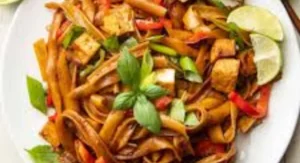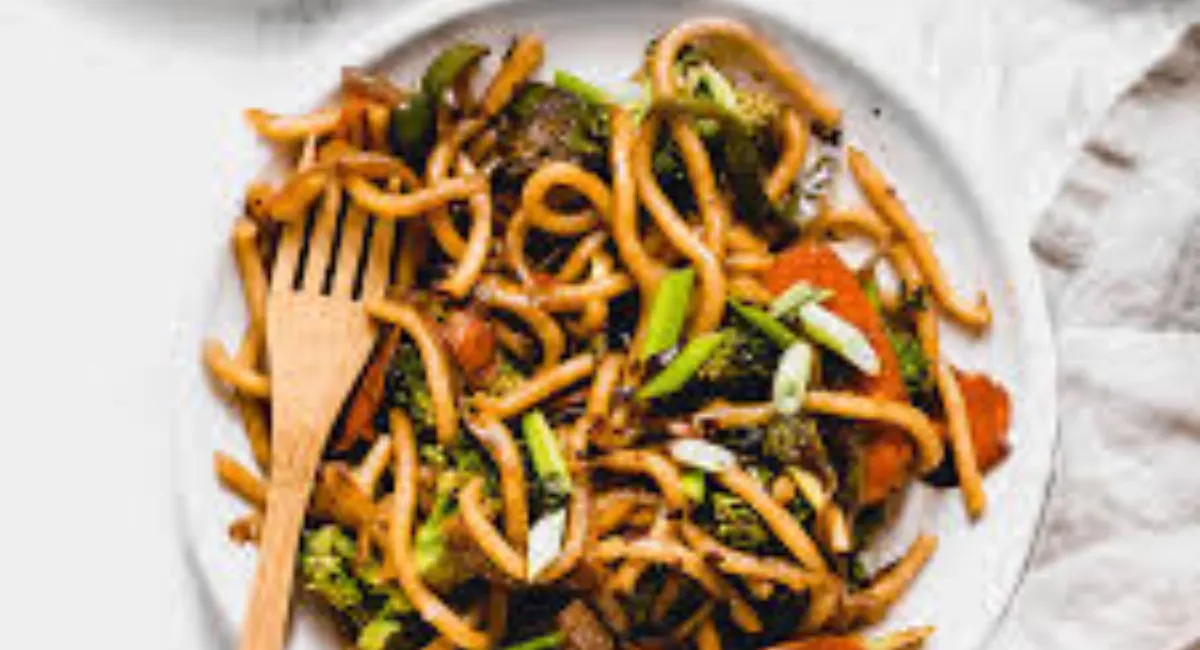Why You’ll Love This Drunken Noodles Recipe
You’ve come to the right place if you’re craving something spicy, savory, and utterly satisfying. This drunken noodles recipe is the perfect solution for noodle lovers who want restaurant-quality Thai food at home. Known in Thailand as Pad Kee Mao, drunken noodles are a stir-fry dish packed with wide rice noodles, fresh veggies, fragrant basil, and an irresistibly spicy and slightly sweet sauce.
But don’t worry — you don’t need to be a professional chef to pull this off. This drunken noodles recipe is simple enough for weeknights yet impressive enough to serve guests. Let’s dive into how to make this Thai classic from scratch!
What Are Drunken Noodles? A Brief Background
Despite the name, there’s no alcohol in traditional drunken noodles. The popular theory is that the dish is so spicy it supposedly “sobers up” anyone who’s had a bit too much to drink — hence the name.
Drunken noodles are beloved for their bold flavors and the balance of spicy, sweet, salty, and umami notes. It’s a staple in Thai restaurants worldwide and increasingly popular among home cooks. You can learn more about Thai cuisine’s flavor profiles from TasteAtlas.
Ingredients You’ll Need for This Drunken Noodles Recipe
The beauty of this drunken noodles recipe is how accessible the ingredients are. Here’s what you’ll need:
Noodles
Wide rice noodles (fresh or dried)
Hot water (for soaking dried noodles)
Protein (Choose One)
Chicken breast or thighs
Shrimp
Tofu for a vegetarian option
Beef or pork slices
Vegetables
Red bell pepper
Onion
Baby corn
Broccoli
Thai basil leaves (or sweet basil if Thai basil isn’t available)
Sauce Ingredients
Soy sauce
Oyster sauce
Fish sauce
Dark soy sauce
Brown sugar
Garlic
Thai bird’s eye chilies (adjust to heat tolerance)
These ingredients create the signature taste that makes this drunken noodles recipe unforgettable.
Step-by-Step Drunken Noodles Recipe
1: Prepare the Noodles
If using dried rice noodles, soak them in hot water per package instructions until pliable but not mushy. Drain and set aside.
2: Make the Sauce
In a small bowl, mix:
- 3 tablespoons soy sauce
- 2 tablespoons oyster sauce
- 1 tablespoon fish sauce
- 1 tablespoon dark soy sauce
- 2 teaspoons brown sugar
This sauce is the heart of your drunken noodles recipe!
3: Stir-Fry the Aromatics
- Heat 2 tablespoons of oil in a wok over high heat.
- Add chopped garlic and sliced chilies. Stir-fry quickly until fragrant (about 30 seconds).
4: Cook the Protein
- Add your chosen protein (chicken, shrimp, beef, or tofu).
- Stir-fry until cooked through. Remove and set aside if needed to avoid overcooking.
5: Stir-Fry Vegetables
- In the same wok, add sliced onions, bell peppers, baby corn, and broccoli.
- Stir-fry for 2-3 minutes until slightly tender but still crisp.
6: Combine Everything
- Return the protein to the wok.
- Add the prepared sauce and noodles.
- Toss well over high heat so everything is evenly coated.
- Finally, toss in fresh basil leaves until wilted.
7: Serve Hot
- Plate your drunken noodles immediately while steaming hot.
- Garnish with extra chilies, lime wedges, or chopped basil if desired.
- And there you have it — a sizzling, aromatic drunken noodles recipe ready to enjoy!

Tips for Perfect Drunken Noodles Every Time
Use Fresh Thai Basil
Thai basil has a spicy, peppery note that sweet basil lacks. It’s a crucial ingredient in authentic drunken noodles recipes.
Adjust Heat Level
Drunken noodles are typically spicy, but you can easily adjust the number of chilies based on your spice tolerance. If you’re unsure, start with fewer chilies and add more to taste.
Don’t Overcook the Noodles
Overcooked rice noodles can become mushy. Keep them slightly undercooked during soaking, as they’ll finish cooking in the wok.
Use a Hot Wok
High heat is key for the smoky, “wok hei” flavor typical in Thai stir-fries. Don’t crowd the pan, or you’ll end up steaming the ingredients instead of stir-frying.
For more stir-fry techniques, check out Serious Eats.
Variations on Drunken Noodles Recipe
One of the best things about a good drunken noodles recipe is how versatile it can be:
- Vegetarian Version: Replace fish sauce with soy sauce and use tofu for protein.
- Seafood Twist: Use shrimp or scallops for a lighter, seafood-forward dish.
- Extra Spicy: Add more bird’s eye chilies or a splash of chili oil.
Feel free to experiment to make your perfect drunken noodles recipe!
Why Make Drunken Noodles at Home?
Restaurant drunken noodles are delicious, but homemade versions offer:
- Control over spices and ingredients
- Fresher flavors
- Customization for dietary needs
- A fraction of the restaurant price
- Once you try this drunken noodles recipe, you’ll see why it’s worth making at home.
Serving Suggestions
Pair your drunken noodles with:
- Thai iced tea for a cooling contrast
- A simple cucumber salad
- Crispy spring rolls as an appetizer
- These pairings make your homemade Thai meal feel like a restaurant experience.
Frequently Asked Questions
-
Can I use spaghetti instead of rice noodles?
Technically, yes, but it won’t taste quite the same. Rice noodles absorb the sauce differently and provide the authentic texture of a true drunken noodles recipe.
-
Are drunken noodles gluten-free?
They can be! Use gluten-free soy sauce and oyster sauce alternatives, and check labels carefully.
-
Why are they called drunken noodles?
It’s not because of alcohol in the dish—it’s because the spicy flavors supposedly “wake you up” if you’ve been drinking.
Summary:
There’s nothing quite like a steaming plate of spicy, savory drunken noodles. This easy yet authentic drunken noodles recipe lets you recreate those restaurant flavors right in your kitchen. Once you try it, you’ll understand why this dish has become such a global favorite.

